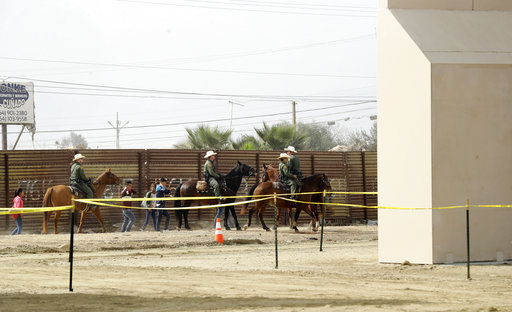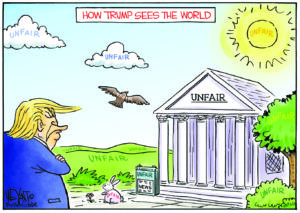Prototypes for Trump’s Border Wall Rise in San Diego
Amid huge cost estimates and falling apprehension about illegal crossings, it is uncertain that Congress will fund a wall along the entire U.S.-Mexico border. Border Patrol agents on horseback detain a group that crossed from Tijuana, Mexico, on Thursday near the San Diego construction site of prototypes for a border wall. (Gregory Bull / AP)
Border Patrol agents on horseback detain a group that crossed from Tijuana, Mexico, on Thursday near the San Diego construction site of prototypes for a border wall. (Gregory Bull / AP)
Eight 30-foot-tall prototypes of President Trump’s long-promised U.S.-Mexico border wall are under construction in San Diego, providing glimpses of what any barrier might end up looking like.
Construction on 8 wall prototypes began today in San Diego. The prototypes are designed to deter illegal border crossings. (1/2) pic.twitter.com/WB1rIojgLj
— CBP (@CustomsBorder) September 26, 2017
NPR provides additional details:
Four are solid concrete; four are made of steel and concrete; one is topped with spikes. They all approach 30 feet in height. Customs and Border Protection is paying $20 million to six construction companies from Mississippi, Maryland, Alabama, Texas and Arizona. Crews in white hardhats operating cranes and forklifts are expected to complete the models by the end of the month.
Once the sections of wall are finished, CBP — parent agency of the Border Patrol — will evaluate them for three criteria.
“We want a better barrier. One that is hard to scale, hard to penetrate and hard to tunnel under,” says Roy Villareal, chief of the San Diego Border Patrol sector.
“We’re hoping innovation from private industry combined with our experience generates the next evolution of border security infrastructure,” he continues.
The construction site is about two miles east of San Diego’s Otay Mesa border crossing. Gizmodo points out that the prototypes will do nothing to stop aerial drones from transporting illegal drugs over a wall. With drones becoming more numerous and cheaper, it seems unlikely that a wall itself will stop “drugs from pouring into this country,” as Trump has insisted would be the case ever since he launched his presidential campaign.
NPR reports that the prototype project was handled by six independent contractors, and that the final design could use elements of any number of the prototypes.
It is unclear whether the prototypes will pave the way for an actual wall to be built. Each design is projected to cost the Department of Homeland Security (DHS) between $300,000 and $500,000. If each of the prototypes approaches the upper end of the estimate, then the experimental project will cost close to $4 million before testing even begins. Doris Meissner, a former immigration commissioner and now a senior fellow at the nonpartisan Migration Policy Institute, said, “The real issue with building a border wall is what the Congress does, not what the contractors do. … The price tag on this is enormous.”
Which border wall prototype is your favorite? pic.twitter.com/3lYncjkwAd
— Jacob Wohl (@JacobAWohl) October 14, 2017
Victor Monjarrez, a former Border Patrol sector chief in Tucson, Ariz., and currently associate director of the Center for Law and Human Behavior at the University of Texas at El Paso, told NPR that “as apprehensions continue to decline, it does become tougher to get the funding approval.” NPR continues:
“We knew this was political theater (from the Trump administration) and we’re not going to respond,” says Christian Ramirez, director of the Southern Border Communities Coalition in San Diego. “This is much ado about nothing.” He says the much photographed prototypes represent “a guise that a border wall is being built” to please Trump supporters who chanted “Build the wall!” during the campaign.
On Tuesday, the president tweeted, “BORDER WALL prototypes underway!” above pictures of the massive sand-colored barriers. Sector Chief Roy Villareal declines to predict the future of the prototypes, or say whether they are, in fact, a model for a wall to be ultimately constructed somewhere along the southern frontier. “Part of the intent of the prototypes is to influence the ultimate design of new border fencing,” he says. “[The final design] may well not be what you witnessed this morning.”
The Trump administration has asked Congress for $1.6 billion for 74 miles of new border wall, and the request is pending as Congress considers broader border security and immigration legislation.
Your support matters…
Independent journalism is under threat and overshadowed by heavily funded mainstream media.
You can help level the playing field. Become a member.
Your tax-deductible contribution keeps us digging beneath the headlines to give you thought-provoking, investigative reporting and analysis that unearths what's really happening- without compromise.
Give today to support our courageous, independent journalists.






You need to be a supporter to comment.
There are currently no responses to this article.
Be the first to respond.